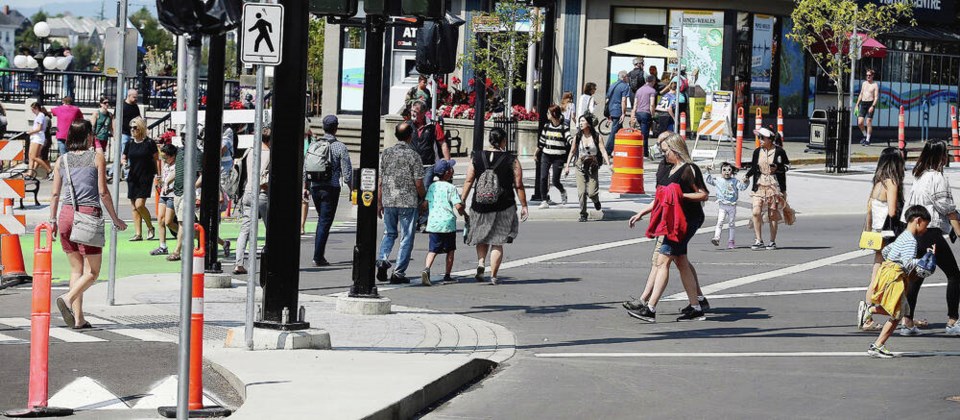It’s an activity that can put you at risk of broken bones, skin lacerations, cuts and permanent scarring. Traumatic brain injuries, paralysis, burns and severe internal injuries are also common.
No, it’s not Brahma bullriding, or being a part of the Hollywood stunt actors guild. These severe, life-changing wounds are the most common injuries for pedestrians using crosswalks who are struck by vehicles.
About 300 pedestrians are killed in Canada each year, many of them while using crosswalks. In the U.S., the number tops 7,500.
Crosswalks were invented to provide pedestrians with a safe and legal path to cross roads. But creating them often causes a false sense of security as well — that idea that I’m protected by some sort of magical forcefield.
Using a crosswalk is a risk — full stop — and drivers and pedestrians have responsibility to mitigate those risks.
What are common risks present at a crosswalk?
First up, there is the uncontrolled intersection. The absence of any signage or signal lights to warn drivers about potential road crossers is a particular danger. The lack of warning signs or lights, usually on streets with light traffic flow, may create an impression of more safety for pedestrians. Pedestrian vigilance is often reduced as a result.
Midblock crosswalks have always been a concern for me. Drivers are conditioned to look for pedestrians at major intersections, though many crosswalk users might disagree. A crosswalk in the middle of a block does not always register for some drivers, especially when one car passes another vehicle who is slowing or stopping for a pedestrian. I saw so many near misses when I drove regularly in Vancouver that I lost count.
We put pedestrians at more risk when crosswalks are laid down in high-speed areas. These areas usually come with heavier traffic volumes, and in doing that, we double the risk for people trying to cross those fast-moving busy streets. Being struck by a vehicle at 50 km/h or better will most probably be a catastrophe for a pedestrian. Crosswalks in this type of driving environment should be avoided right from the planning stage.
LED lighting has transformed many aspects of road safety because of its enhanced power to illuminate streetscapes as well as create much more visible warning lights. But inadequately lit areas are still a factor in pedestrian collisions. The most important sense for a driver is eyesight. Being able to clearly see pedestrians not only using a crosswalk but also when they are approaching the road is a key factor in preventing pedestrians from being hit.
Although we are inundated with signs along our roadways these days, I’ve seen several areas where an advanced warning of an approaching crosswalk is required. Just having the classic old black-and-white sign with a stick figure crossing the road placed right beside a crosswalk is often not enough to alert drivers.
Decades of research by experts in the fields of trauma prevention, urban planning and traffic safety say these are the best tips around pedestrian safety:
• Use crosswalks. Crossing in the middle of the road or darting through traffic is one of the most dangerous moves a pedestrian can make.
• Obey the signals. By now you’ll know that I’m against the countdown signal next to pedestrian control lights. It’s a licence for peds to just keep on walking. Trouble is, there’s a whole cadre of impatient drivers waiting to dart around the corner or get through that intersection. Peds who “keep on trucking” put themselves at much greater risk.
• Make eye contact. This could also be the most important tip, because knowing that a driver is seeing you is actually your last line of defence in preventing being struck.
• Watch out for turning vehicles. A high percentage of pedestrian collisions occur with vehicles turning at intersections. Look behind you for that left-turning vehicle as you head across the street. Make sure the right-turning driver knows you are going to step out.
• Stay alert. Texting while you amble along — head down or being “tuned out” with headphones is dangerous.
• Stay sober. Twenty-five per cent of pedestrian fatalities involved the pedestrian being over legal blood alcohol limits.
Finally, drivers have to be much more aware about pedestrian vulnerability. Just because you can zip out and make that right turn before pedestrians get too close to you doesn’t mean you should do it.
Drivers must also account for bad weather and the reduced visibility that comes with it. Pedestrians have rights, so vigilance and a prudent speed in crowded areas are essential for their safety. As a driver, you now also have an enhanced legal duty of care for all vulnerable road users.



